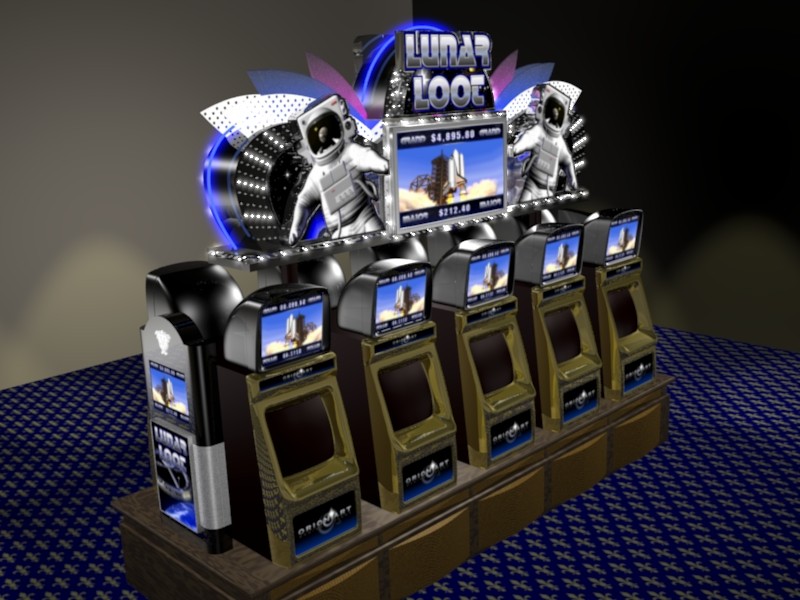OK, I’ll try and cover all the points raised.
I haven’t brought this up yet but I’ve noticed Blender is becoming more and more unstable the more I do to this file. It’s shutting down about once every three attempts at rendering which scares me as I’d hate for it to do it after hours of rendering my final movie or something. It even bombs while I’m just editing occasionally. Any thoughts there?
Firstly, the size was set at 800 x 600 with OSA 8 and I have previously rendered a 500 frame animation of this scene at these settings with camera moving from one end to another but without that big sign abover the poker machines. Strangely enough the frames were only taking a minute or two to render back then (this was before I started building that big sign you see there). The resulting .avi file does actually playback a bit jerky (on windows media player) as dgebel suggested it might.
I just rendered the same scene but selected 50% and it’s just way too small for my purposes.
I’m a bit confused, I use a 21" wide screen minitor which I would say is probably smaller than the average domestic TV set these days yet dgebel, you say that 800 x 600 is way bigger than standard TV yet my images and movies at 800 x 600 only fill up just under a quarter of my monitor when viewed in Windows Media Player or Windows Picture and Fax Viewer and when I zoom in to stretch it to fit my whole monitor the picture quality deteriorates a lot. Pardon my ignorance but I just don’t get that side of it yet. Are these (800 x 600) pixel settings? Screen Resolutions? I don’t understand.
Thing is, the final movie will be presented to clients on either a laptop or through a TV screen and we would want it to fit the whole screen and be nice and sharp, it also may later get used for things like expos and run through 42" plasma screens. Played on this size screen it would expand the image so much it would appear blury if I made it too small wouldn’t it? I will probably use some sort of video editing software and create a dvd to give to the clients to keep.
Can I just say off the track a bit, ResPower was a hell of a lot more expensive than I thought it was going to be! I could buy a swanky new system with all the trimmings by the time I did 10 movies with them going by their estimates (I’d assume $20,000 would buy me a pretty fast 3D work station wouldn’t it?).
The jerkiness I was refering to in my earlier posting was when editing, you know, moving around holding down the MMB or Shift MMB or zooming etc all in the 3D window. I had a look at the NVIDIA web site and I think the graphics card I currently have retails for about AU$110 and there are some I found specifically designed for 3D and CAD work which go up to $3,800. So I figure if I upgrade mine and spend around $800 to $1000 I should hopefully see significant improvements there. It’s the render time I am mostly concerned with and would like to find a way to do it in house.
I have learnt what I know so far in Blender on this, my first project that you see so yes, I did go a little nuts with lighting and subsurfing earlier on in it’s creation before I came to learn of these things from you good people but I do need the raytracing I think as with my line of work there’s lots of polished gold and silver materials used, so, can’t gat past that one.
I’ve tried turning off OSA and it’s just not as good, (once you’ve seen how good it can be it’s hard settle for less). I have avoided ambient occlusion as I think for my purposes it’s just not necessary. I don’t need motion blur either.
I still don’t get the whole Octree resolution thing even after following the link CD38 supplied (must admit it was the wee hours when I was trying to get my head around it) and I noticed my rendering time is chewed up a lot with it ‘Filling Octree’
I might try taking out a few lamps as I have them spread around the room shining down the walls to help create a casino style atmosphere.
I’m still yet to attempt to put a video image as the texture in all those screens to be playing as my camera moves around the room so god knows what thats gonna add to my render time too.
There are 5,086,682 vertices in the seen. (This is the Ve: quantity at the top left of the render window I’m assuming).
May be just showing our clients still shots of this by the looks of it, which is a shame really. I had no idea what a major field rendering was when I started using blender. “Renderfarms” - strange concept for me still.
 ).
).
